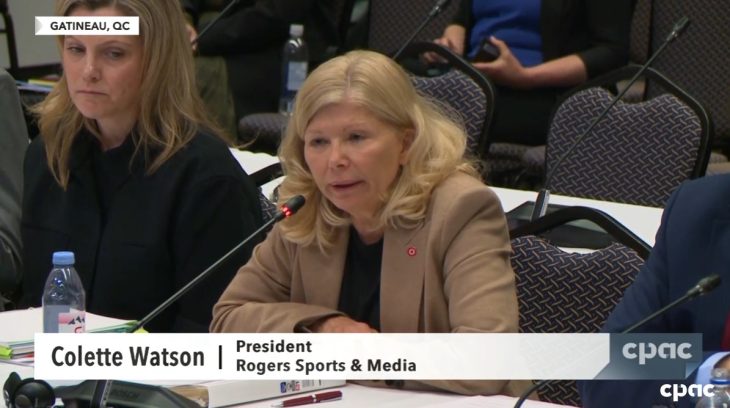
By Ahmad Hathout
Rogers executives said Friday they feared the CRTC would come out of its hearings on the modernization of the Broadcasting Act emboldened to try to regulate some of the issues it has identified during its current proceeding instead of loosening the regulatory grip it has had on traditional broadcasters.
“We can’t rely on the traditional tools anymore,” said Dean Shaikh, the company’s senior vice president of regulatory affairs. “We no longer have a closed system. We’re competing against massive online streaming giants that have no rules. We need much more flexibility to compete for audiences, subscribers, advertising dollars with programming that meets the needs and desires of Canadians that will include programming that responds to the needs of equity-deserving groups.
“We can’t come out of this proceeding with more funds imposed on the traditional system, more rules, more onerous obligations, more dedicated CPE [Canadian programming expenditures].”
Rogers agreed with other private broadcasters about the overall direction the CRTC needs to take – make foreign streamers contribute equitably but also lower the burden on traditional broadcasters – and urged the commission to allow them to more freely move money around to meet where their audiences are going.
On a couple of occasions during their appearance, the cableco’s executives kept steering the attention of CRTC panel members to news, which they said is a primary example of “at-risk” programming that is not profitable and that badly needs a rethinking.
“If you relied entirely on the market, even though there’s audience demand, you might not be able to produce programming to meet that audience demand,” Shaikh said about news. “And that’s why you need to introduce some framework. And in our case, it’s our model which provides us with greater flexibility to serve that audience. I think that’s an example where you really have to have the right balance of trusting the market but relying on regular tools, primarily flexibility to respond to audience demand.”
Rogers proposes a simplified framework wherein its entire broadcasting business will make a single contribution of no more than five per cent of its total BDU and media revenues to CanCon funds.
The cableco further proposes that it will focus on local, community and third-language news and information programming, with an exemption from the community TV policy.
Rogers said Friday that the requirements of the community TV policy – quotas for locally reflective news, from which Bell asked Thursday for a reprieve – is crippling its ability to adapt.
“We agree wholeheartedly with BCE that the locally reflective, locally relevant reporting be gone,” Colette Watson, president of Rogers Sports and Media, said pointedly about the admin work that that entails, “…not because we don’t want to do the programming, [but] because it is an administrative nightmare to implement and report on.
“We hire humans to do that rather than go report on local news.”
Watson said the company is okay with the exhibition requirements the CRTC imposes on it to produce that type of content but urged it to eliminate the reporting part.
“It feels punitive. It feels mistrustful. And it’s not reflective of where the money should go,” Watson added. “News is not easy to monetize … We’re losing money on news. But we’re not saying I don’t want to do news anymore. We want to do news. We will continue to do news.”
Watson also said the company wants to unlock money tied up in the community TV policy to make it more economical to cover local information and public affairs at a more granular level.
While it wants to be left more to its own devices, Rogers also said it believes all players in the system should contribute to the Independent Local News Fund (ILNF), which the Canadian affiliate of the Motion Picture Association is fighting against in court.
At the urging of the commission, Rogers also addressed other at-risk programs, specifically children’s programming.
Rogers has been seeking to remove several of Corus’s channels related to children’s programming from its cable package due to what it said is underperformance. The cable giant has previously indicated that the decline in viewership on children’s programming has significantly outpaced overall television viewership as that demographic moves online.
Rogers used the same reasoning Friday to address the children’s programming question: “From our perspective, this is not a case of market failure. This is actually a market outcome,” Shaikh said. “This is a response to a functioning market. Audiences – in this case, kids – have spoken, and they’re leaving the traditional system.
“My fear is that because there’s a perceived market outcome that the commission is not satisfied with, it may introduce regulatory tools that really aren’t about market failure but actually create market distortions and inefficiencies,” he added.
“In the case of kids programming, it’s a demand issue. Kids don’t want programming from traditional platforms in the way they historically did. The right response to an issue of decreasing demand is not to increase supply. And my fear is in this hearing, there’s been a suggestion that because kids are leaving the traditional system, maybe we need to fund more or dedicate more funds to kids programming, allocate some CPE to kids programming.
“If you introduce a new fund or funding commitment or CPE commitments, you’ll be taking money away from things like local news that in our model, we would like to continue to support.”
Rogers said it anticipates that its proposal to put contributions into a private certified independent production fund (CIPF) would assist in the production of kids content.
Otherwise, the cable giant suggested – as Quebecor and Bell have before it – that the public broadcaster could take more responsibility for the supply of that content if the CRTC sees it as matter requiring regulatory intervention.



